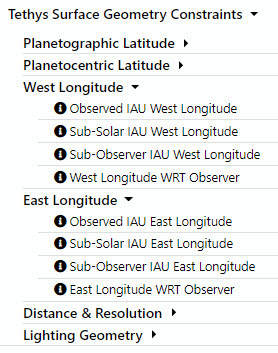For the past few months we have been busy developing new geometric metadata (surface and ring) for Galileo SSI observations. We also developed new preview images and diagrams for Voyager PPS, RSS, UVS, and ISS occultations and reflectance profiles.
Galileo SSI Geometric Metadata
OPUS now supports full geometric metadata for all Galileo SSI observations. The list of instruments supporting geometric metadata includes Cassini ISS, UVIS, and VIMS, Galileo SSI, New Horizons LORRI, and Voyager ISS. We will continue to add instruments in the months ahead. As a reminder, geometric metadata includes surface geometry for all bodies in the field of view as well as geometry for the main planet's ring system.
Voyager Occultation Previews and Diagrams
Continuing our long-standing tradition of creating custom previews and diagrams that enable easy and rapid browsing of search results, we have created brand new preview images and diagrams for the Voyager VG_28xx volumes covering occultations from Voyager PPS, RSS, and UVS, and reflectance profiles from Voyager ISS. The preview images show the actual occultation profile, while the diagrams show the progress of the occultation across the ring plane. Various colors indicate the wavelength ranges used. The diagrams are shown on the Browse tab when available, and the previews are available on the Detail tab or during download from the cart.
Miscellaneous Changes
- We fixed a number of problems with the import of metadata for the COCIRS_0xxx and COCIRS_1xxx volumes.
- The previously-named "Extended Mission" and "Extended-Extended Mission" Cassini Mission Phases have been changed to "Equinox Mission (XM)" and "Solstice Mission (XXM)" for consistency.



































